It was around June this year. A friend of mine, a fellow stationery enthusiast, asked if I’ve heard of the bullet journal. She’d seen my to-do lists and how obsessed I am with productivity. She thought the bullet journal was right up my alley.
She was right. Six months and one bullet journal later, it most certainly was is right up my alley.

I’ve finally made it to the last page. So today, as I transition to a new notebook, I’ll go over the lessons I learned from my first bullet journal.
But first, what is a bullet journal?
The Bullet Journal is a customizable and forgiving organization system. It can be your to-do list, sketchbook, notebook, and diary, but most likely, it will be all of the above.
-“The System”, bulletjournal.com
Hang around long enough in any productivity site (Lifehacker, anyone?) and you’re bound to hear about the bullet journal, or BuJo for short. A quick search of #bulletjournal or #bujo through any social media platform greets us with images of neatly-inked notebook pages.
The creator’s site (above) is already a pretty accurate answer as to what a bullet journal is. So instead, I will define what a bullet journal is by how I use it:
For me, a bullet journal is a systematic to-do list.
Danna’s bullet journal: A love story
My love of to-do lists established, what the bullet journal offered was a way to take my to-do lists to the next level. It offered a simple way to track and migrate the tasks from my to-do lists, from one day to the next.
It does this through it’s namesake: the bullets.
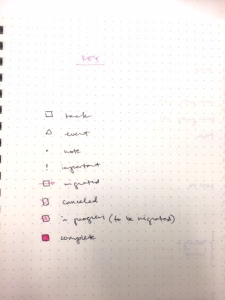
The bullets also offered the option of writing down non-tasks without having to establish a separate “place” for them.
By changing the bullet, I can change the context of the text that comes after–Is it a task? An event? A note to self? This eliminated the need for having a separate journal and day planner.
These bullets were the primary reason why I knew the bullet journal system was going to work. It was easy. It was just extending something I already do (to-do lists), but offered a system for not a lot of extra effort.
What does my bullet journal look like?
To commemorate, I want to show off what my old bullet journal was like before I bid it goodbye.
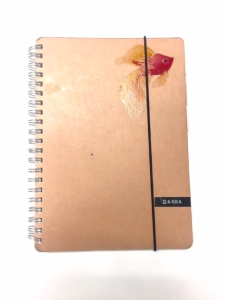
I use an A5 double-ring 70-sheet notebook from Muji. On the cover is a watercolor temporary tattoo I painted in class and a sticker label of my name. There’s a built-in elastic to keep the notebook in place.
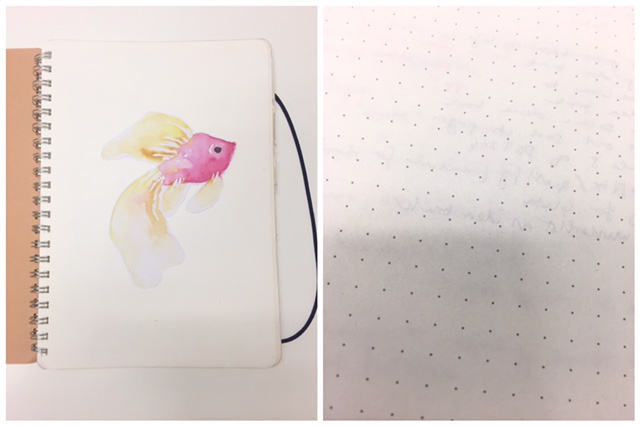
On the first page of my bujo is the original of the watercolor tattoo. The pages are cream-colored and made of recycled paper. I use dot grid because it strikes a nice balance: It has the structure of lined and grid notebooks, but with more freedom akin to blank sketch pads.
I stick to two colors of ink: black and pink. No special reason this time.
Lessons learned while migrating to a new bujo
As I migrate to a new bullet journal, I’ve had the chance to review the old one. I’ve had the chance to review what went well, and what I could have done better. I’ve listed down the lessons learned here.
Learn from my mistakes–so you won’t need to make them in case you ever decide to give bullet journaling a try.
1. Put the index at the back
If you follow the classic bullet journal format, it will tell you to allocate about 2-4 of the first few pages of your notebook for the index.
But, is two too few? Is four too much?
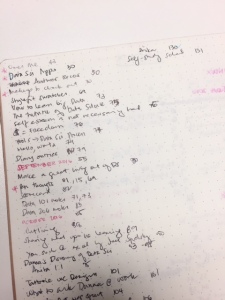
In my case, I allotted two pages and ended up about two lines too short. As per above, I squeezed in the two lines into a second column.
Moving forward, I will do what books do: Put the index at the back. My entries and the index will then meet somewhere in the middle.
No more worries on how many pages to allot!
2. Use categories

When I started on the bujo, I had listed all the tasks along a single column like I would a to-do list. This was okay for the first few weeks, but as I got used to the bujo and started listing more and more tasks, the single list started to get confusing.
Respond to Brad’s email? About which?
And which report was I was supposed to update again?
Why did I have to do this again?
Etcetera. To resolve this, I added categories before the tasks to help give context. As a bonus, it complemented the Outlook categories I was already using.
3. Don’t be afraid of whitespace
In an attempt to save paper, I would sometimes put 2-3 unrelated topics on the same page.
This wreaked havoc on my index, especially when I would add something new to an existing topic and found I didn’t have enough space. Moving forward I’ll stick to 1-2 topics per page, never more.
4. Rapid log as often as you can
Something I realized while reviewing my old bullet journal: I underutilized its journaling capabilities. While I would occasionally note an event or thought, I found that for the most part I would still refer to emails and phone messages when trying to recall when did I do something.
If I had chronicled it properly in the first place, this shouldn’t have been a problem.
5. A bujo is not an art journal
One of my friends had started on her bullet journal around the same time as I did. She even bought a fancy notebook and a couple of expensive pens to go along with it. Six months later, and she still hasn’t gone past the first few pages.
I asked her why, and she said it’s because she didn’t want to ruin how it looked.
Like myself, this friend frenziedly writes up a to-do list first thing in the morning.
Unlike myself, she doesn’t do this on her bullet journal. Instead she writes it on a memo pad we got as a freebie.
Not the bullet journal, she says. It’s too pretty for that.
Look up #bulletjournal online and you’ll see artsy pages decorated with calligraphy, collages, and illustrations. It’s easy to correlate that because other people make bujos an art journal, that it’s the proper way to do it.
It’s not.
The whole point of the bullet journal is customization. You make it work for you. If you like making art journals, go ahead.
I don’t. Rather, I can’t. Not in the morning when I’m gulping in my daily caffeine while rushing off to a meeting.
My use of the bullet journal is utilitarian. It’s just a bunch of to-do lists broken up by the occasional essay draft. It’s not pretty to look at, but it’s damn useful.
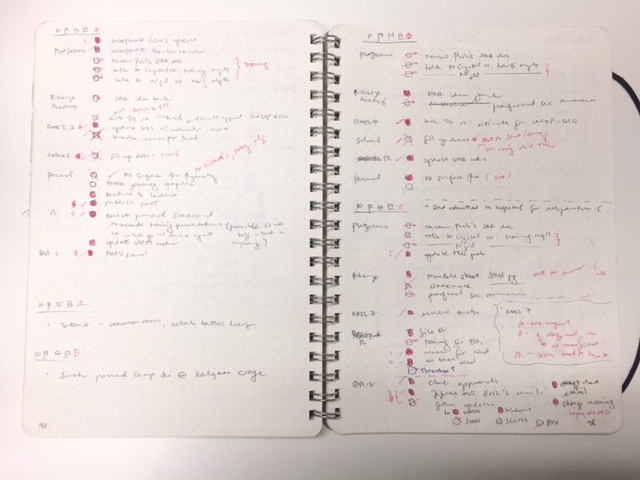
That’s the big lesson really.
